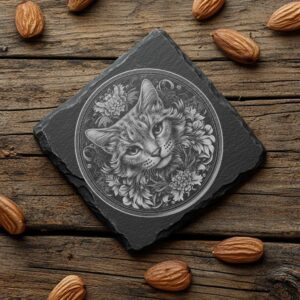-
×
 Slate Coaster File | Cat & Flower 3D Illusion PNG Decor
1 ×
Slate Coaster File | Cat & Flower 3D Illusion PNG Decor
1 ×$6.00Original price was: $6.00.$4.50Current price is: $4.50.(25% off)
1 Answers
Best Answer
The design process for 2D and 3D laser cut files differs significantly due to the dimensional complexity and the nature of the final output:
2D Laser Cut Files:
- Vector-Based Design: 2D designs focus on creating paths, outlines, or shapes in a 2-dimensional space using software like Adobe Illustrator or CAD programs.
- Simplicity in Geometry: Designs are typically flat and lack depth, focusing on shapes, patterns, or cutouts without intricate layering or depth variations.
- Precision in Lines and Paths: Emphasis is on precise lines for cutting, scoring, or engraving, requiring clarity in line formatting for the laser to interpret accurately.
- Material Thickness Consideration: Designs account for material thickness but lack volumetric aspects, focusing on shapes that can be cut or engraved on a single plane.
3D Laser Cut Files:
- 3D Modeling Software: Designs involve 3D modeling software like SolidWorks, Rhino, or Blender, creating volumetric models with depth, layers, and complex geometries.
- Depth and Layering: Considerations extend beyond flat surfaces, involving intricacies in layering, assemblies, and 3-dimensional structures.
- Material Volume and Shape: Designs focus on volumetric shapes, often requiring slicing or tessellation techniques to translate 3D models into printable layers for laser cutting.
- Complexity in Assembly: Assemblies or interlocking parts might be integral to 3D designs, demanding precise tolerances and intricate fitting considerations.
The 2D design process concentrates on planar surfaces and precise geometries, while 3D design involves volumetric considerations, layering, and complexity in assembly or interlocking parts. The latter necessitates a deeper understanding of 3D modeling and manufacturing techniques to ensure successful fabrication.
Related Questions
- What software or tools are commonly used for designing projects intended for laser cutting?
- What are the key factors to consider when designing intricate or detailed patterns for laser cutting?
- Are there specific design considerations for optimizing material usage and reducing waste in laser cutting projects?
- How do designers test and ensure the compatibility of their designs with the capabilities of different laser cutting machines?
- Are there any design guidelines or best practices to ensure safety and precision in laser cutting projects?

 Slate Coaster File | Cat & Flower 3D Illusion PNG Decor
Slate Coaster File | Cat & Flower 3D Illusion PNG Decor